Lack of Mid1, the mouse ortholog of the Opitz syndrome gene, causes abnormal development of the anterior cerebellar vermis
- PMID: 20181585
- PMCID: PMC6633954
- DOI: 10.1523/JNEUROSCI.4196-09.2010
Lack of Mid1, the mouse ortholog of the Opitz syndrome gene, causes abnormal development of the anterior cerebellar vermis
Abstract
Opitz G/BBB syndrome (OS) is a genetic disorder characterized by midline developmental defects. Male patients with the X-linked form of OS, caused by loss-of-function mutations in the MID1 gene, show high variability of the clinical signs. MID1 encodes a ubiquitin ligase that controls phosphatase 2A, but its role in the pathogenesis of the disease is still unclear. Here, we report a mouse line carrying a nonfunctional ortholog of the human MID1 gene, Mid1. Mid1-null mice show the brain anatomical defect observed in patients (i.e., hypoplasia of the anterior portion of the medial cerebellum, the vermis). We found that the presence of this defect correlates with motor coordination and procedural and nonassociative learning impairments. The defect is limited to the most anterior lobes of the vermis, the region of the developing cerebellum adjacent to the dorsal midbrain. Analyses at midgestation reveal that lack of Mid1 causes the shortening of the posterior dorsal midbrain, the rostralization of the midbrain/cerebellum boundary, and the downregulation of a key player in the development of this region, Fgf17. Thus, lack of Mid1 causes a misspecification of the midbrain/cerebellar boundary that results in an abnormal development of the most anterior cerebellar lobes. This animal model provides a tool for additional in vivo studies of the physiological and pathological role of the Mid1 gene and a system to investigate the development and function of anterior cerebellar domains.
Figures

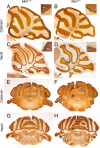
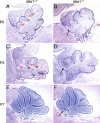
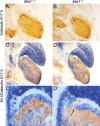
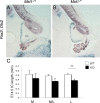
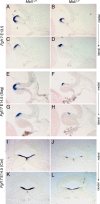

Similar articles
-
MID1-Related Opitz G/BBB Syndrome.2004 Dec 17 [updated 2023 Oct 19]. In: Adam MP, Feldman J, Mirzaa GM, Pagon RA, Wallace SE, Amemiya A, editors. GeneReviews® [Internet]. Seattle (WA): University of Washington, Seattle; 1993–2025. 2004 Dec 17 [updated 2023 Oct 19]. In: Adam MP, Feldman J, Mirzaa GM, Pagon RA, Wallace SE, Amemiya A, editors. GeneReviews® [Internet]. Seattle (WA): University of Washington, Seattle; 1993–2025. PMID: 20301502 Free Books & Documents. Review.
-
Mig12, a novel Opitz syndrome gene product partner, is expressed in the embryonic ventral midline and co-operates with Mid1 to bundle and stabilize microtubules.BMC Cell Biol. 2004 Feb 29;5:9. doi: 10.1186/1471-2121-5-9. BMC Cell Biol. 2004. PMID: 15070402 Free PMC article.
-
The mouse Mid1 gene: implications for the pathogenesis of Opitz syndrome and the evolution of the mammalian pseudoautosomal region.Hum Mol Genet. 1998 Mar;7(3):489-99. doi: 10.1093/hmg/7.3.489. Hum Mol Genet. 1998. PMID: 9467009
-
Rat neurological mutations cerebellar vermis defect and hobble are caused by mutations in the netrin-1 receptor gene Unc5h3.Brain Res Mol Brain Res. 2004 Mar 30;122(2):103-8. doi: 10.1016/j.molbrainres.2003.12.003. Brain Res Mol Brain Res. 2004. PMID: 15010202
-
The MID1 protein is a central player during development and in disease.Front Biosci (Landmark Ed). 2016 Jan 1;21(3):664-82. doi: 10.2741/4413. Front Biosci (Landmark Ed). 2016. PMID: 26709798 Review.
Cited by
-
Midline 1 controls polarization and migration of murine cytotoxic T cells.Immun Inflamm Dis. 2014 Dec;2(4):262-71. doi: 10.1002/iid3.44. Epub 2015 Jan 27. Immun Inflamm Dis. 2014. PMID: 25866633 Free PMC article.
-
Morphometric analysis of the size-adjusted linear dimensions of the skull landmarks revealed craniofacial dysmorphology in Mid1-cKO mice.BMC Genomics. 2023 Feb 9;24(1):68. doi: 10.1186/s12864-023-09162-2. BMC Genomics. 2023. PMID: 36759768 Free PMC article.
-
Cell death as a regulator of cerebellar histogenesis and compartmentation.Cerebellum. 2011 Sep;10(3):373-92. doi: 10.1007/s12311-010-0222-5. Cerebellum. 2011. PMID: 20941559 Review.
-
Bovine spongiform encephalopathy infection alters endogenous retrovirus expression in distinct brain regions of cynomolgus macaques (Macaca fascicularis).Mol Neurodegener. 2011 Jun 23;6(1):44. doi: 10.1186/1750-1326-6-44. Mol Neurodegener. 2011. PMID: 21699683 Free PMC article.
-
X-linked disorders with cerebellar dysgenesis.Orphanet J Rare Dis. 2011 May 15;6:24. doi: 10.1186/1750-1172-6-24. Orphanet J Rare Dis. 2011. PMID: 21569638 Free PMC article. Review.
References
-
- Bobée S, Mariette E, Tremblay-Leveau H, Caston J. Effects of early midline cerebellar lesion on cognitive and emotional functions in the rat. Behav Brain Res. 2000;112:107–117. - PubMed
-
- Broccoli V, Boncinelli E, Wurst W. The caudal limit of Otx2 expression positions the isthmic organizer. Nature. 1999;401:164–168. - PubMed
-
- Buchner G, Montini E, Andolfi G, Quaderi N, Cainarca S, Messali S, Bassi MT, Ballabio A, Meroni G, Franco B. MID2, a homologue of the Opitz syndrome gene MID1: similarities in subcellular localization and differences in expression during development. Hum Mol Genet. 1999;8:1397–1407. - PubMed
Publication types
MeSH terms
Substances
Grants and funding
LinkOut - more resources
Full Text Sources
Medical
Molecular Biology Databases
